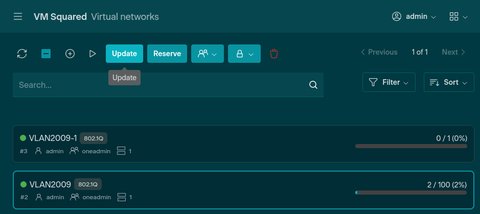Virtual Networks
Virtual Networks emulate physical networks and hardware such as routers and switches to allow the communication between computers, virtual machines, and other devices across various locations. This functionality enables resources separated by vast distances to be connected, pooled, and managed as if they were under one roof.
VM Squared manages both Layer 2 and Layer 3 segmentation and Layer 3 IP Address management for Virtual Networks. Creating a new VNet requires knowing a few pieces of information. If connectivity is desired outside of the VM Squared cluster, the VLAN ID must also be added to trunk ports from the upstream switch fabric into the VM Squared fabric.
Firstly, navigate to Networks then Virtual Networks and click on the

General options
NameArbitrary name of network. Logical names that contain details about the network are useful, but not required.
ClusterUsually leave as default if you only have a single cloud zone.
VLAN ID802.1Q VLAN tag to be used on the network. A value of 0 indicates the untagged network.
Remember to configure switch Ports or LACP groups with the matching VLAN ID before using the Virtual Network.
MTU of the interface
Maximum Transmission Unit, the largest size for Ethernet packets that will be passed on this network. Typical values are 1500 or 9000 bytes. Larger values can help reduce CPU load but must be configured on routers and VMs. If set, this value should match the value in the Context menu. Blank implies 1500.
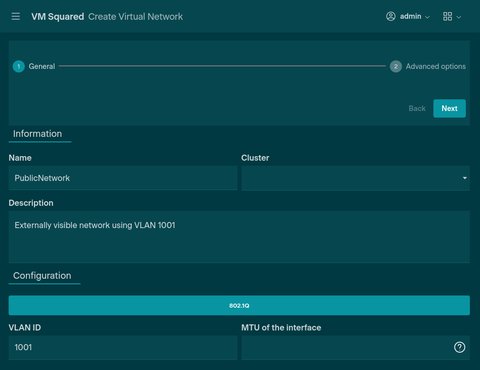
Advanced Options
Address Ranges
Addresses are assigned by creating one or more Address Ranges.
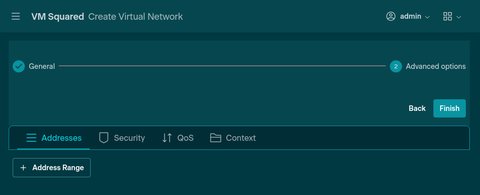
You can select the type of Address Range from one of:
- IPv4 - Only IPv4 addresses are assigned

- IPv4/6 - IPv4 and IPv6 SLAAC addresses are assigned
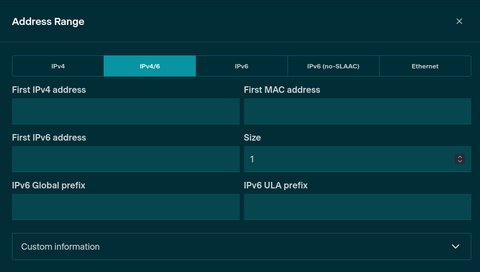
- IPv6 - Only IPv6 SLAAC addresses are assigned
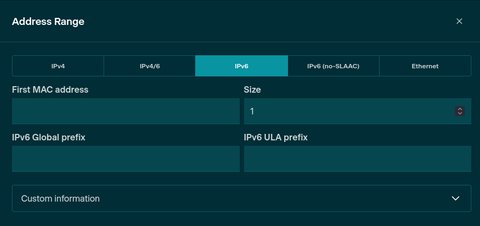
- IPv6 (no-SLAAC) - Only fixed non-global IPv6 addresses are assigned
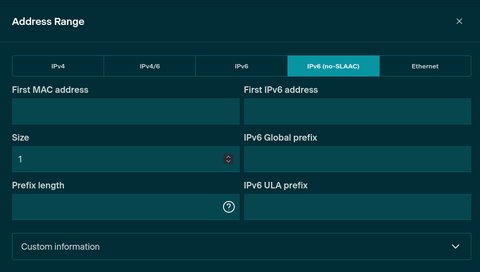
- Ethernet - No IP addresses are configured
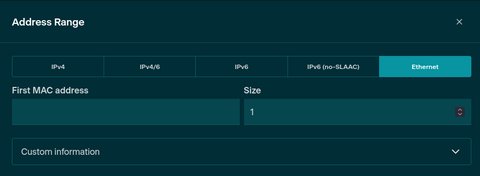
Depending on the type of range some or all of the following fields are available.
First IPv4 addressThe first statically assigned IPv4 address available for assignment to VMs on this range.
First IPv6 addressThe first statically assigned IPv6 address available for assignment to VMs on this range.
IPv6 Global prefixGlobally routable prefix for assignment to VMs on this range.
IPv6 ULA prefixUnique Local Address non-globally reachable prefix for assignment to VMs on this range.
First MAC address
Defines the NIC MAC addresses when attaching VMs to this range. Can be blank.
Size
Number of addresses to be used starting from the First IPv4 address value.
Custom Information
User-defined metadata used to annotate the address range.
Security
Select security groups to apply to this Virtual Network.
The Default security group is applied automatically.
You may wish to redefine the Rules in the Default security group to allow-all Rules in new Virtual Networks.
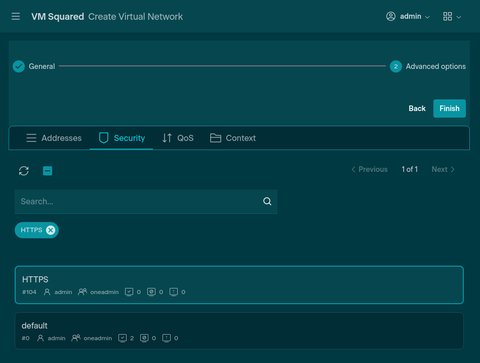
Select one or more Security Groups to apply to this Virtual Network. The resulting firewall rules are an additive combination of all selected Security Groups, so avoid “Allow All” groups if you intend to restrict network traffic.
QoS
Inbound and Outbound traffic can be restricted using these rules.
Average bandwidthLimit for average bandwidth in kilobytes per second.
Peak bandwidthLimit bandwidth peaks beyond this value in kilobytes per second.
Peak burstVolume of data that can be transmitted at the peak bandwidth speed before limiting back to average bandwidth.
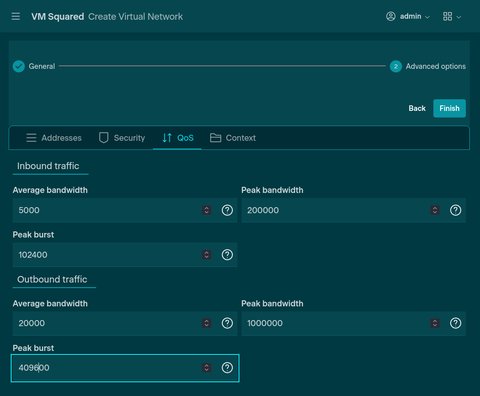
Context
Context is used for values to be given to VMs attached to this Virtual Network.
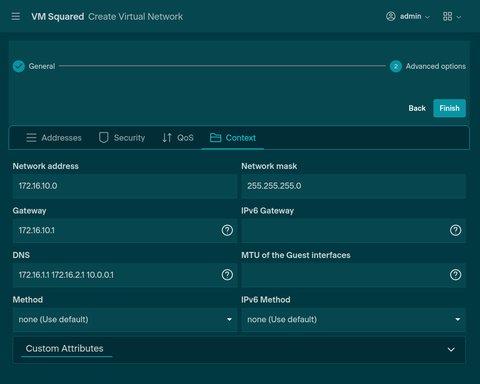
Network addressAddress of the subnet. The network address is the first address of the subnet and typically unusable by clients.
Network maskSubnet mask used to assign allowable addresses in the range using four-octet form where /24 = 255.255.255.0
GatewayThe default IPv4 gateway for all IP traffic on this network.
IPv6 GatewayThe default IPv6 gateway for all IP traffic on this network.
DNSList of DNS servers, space separated.
MTU of the Guest interfacesMTU set on VM’s NICs using this network. This should match the value of MTU set in the General options of the Virtual Network. Blank implies 1500.
Method
Means used to set an IP address on the VMs using this network
none (Use default)- uses “static” option, VM contextualization via a temporary context diskdhcp (DHCPv4)- DHCP is used to setup the VM network configurationskip (Do not configure IPv4)- IPv4 is not setup on VMs using this networkstatic (Based on context)- VM contextualization via a temporary context disk
External Infrastructure Network
An External Infrastructure Network is created implicitly when, for instance, an iSCSI LUN is used by a VM^2 node as storage.
To make a Virtual Network that taps into the External Infrastructure Network one configures the Virtual Network details and in addition provides a BRIDGE Custom Attribute with a value in the form: extinfra.<vlan_id>.
Conversely, it is not possible to create a Virtual Network with a VLAN ID being used by an External Infrastructure Network unless the expected BRIDGE value is provided as well.
The Virtual Network created is not aware of the External Infrastructure Network Addresses in use and a conflict can arise if the configured Virtual Network Address Range includes any External Infrastructure Network Addresses.
Virtual Network Templates
This process can become tedious to set for multiple tenants; therefore, if the general options will be reused for several entities, a Network Template can be created in the same manner as outlined above with the exception of clicking Network Templates in lieu of Virtual Networks.
All of the creation, physical emulation, and management is controlled by VM Squared to present a simplified dashboard to easily instantiate the various portions of the Virtual Network and add machines and attributes to define the access and security.
Reserve
Address Reservations can remove an IP from the available subnet in the defined Address Range. A reservation behaves like a child of an existing Virtual Network containing a subset of the parent Virtual Network’s addresses. The addresses in the reservation cannot be used in the parent Virtual Network while they are part of the Reservation.
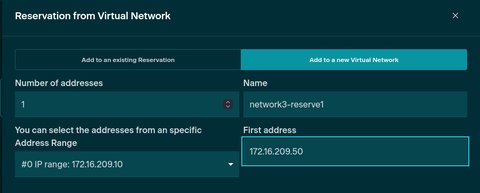
Updating a Virtual Network
Select a Virtual Network and press the Update button to change the settings of an existing Virtual Network. When done making changes, click Finish to apply the settings.
